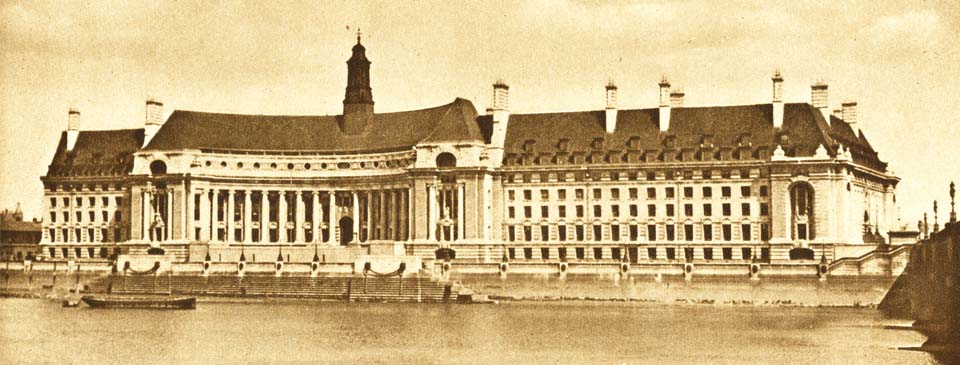In brief – Early-20th century London

County Hall, offices of the London County Council, opened in 1922 on the south side of Westminster Bridge. At that time it was unfinished, hence its lack of symmetry in this photograph. It was built on the site of the earlier Metropolitan Board of Works offices and various wharves and factories. It served as the headquarters of local London government until 1986.
Slowly the Royal Air Force managed to take control of the sky until the raids became more sporadic over London in the spring of 1941, ending in May. London was spared from further attack until January 1944 when German raids resumed. They then arrived twice each day, at nine o’clock in the evening and half past four each morning, with a total of 450 raids occurring in what was known as the ‘Baby Blitz’, petering out by April 1944. By that year Germany had dwindling resources and British air defences had improved. However, a new weapon had been developed that had a devastating effect on London: unmanned flying missiles that became known as V1 rockets. They were slow and eventually became vulnerable to air-defences but in September 1944 Germany began launching a more effective ballistic missile known as the V2. Unlike the earlier V1s they travelled too fast to be hit from the ground. Over 2,000 V1s and over 500 V2s fell on London.
Germany surrendered in May 1945, followed by Japan in August. Londoners celebrated in Trafalgar Square and outside Buckingham Palace. Following the war London was a changed place. Initially it was a partly-devastated city, with central areas and East London in particular littered with bombsites, many that would remain for several decades. The City had suffered its worst destruction since the Great Fire in 1666. Across London 100,000 homes were destroyed beyond repair, nearly 300,000 badly damaged but repairable, and almost two million with slight damage. Hundreds of other buildings, roads, railways, docks, factories and warehouses had been lost, as well as numerous historic buildings. The immediate post-war years were particularly difficult in London. There were shortages of coal, leading to electricity rationing in 1947. Discontent in the workforce brought many strikes, making life harder for everyone. Rationing of food and other products was in place.
The first priority was to repair those homes that had been damaged and it began in 1944, while flying bombs were still falling, under the management of the London Repairs Executive. That work was largely completed by 1947. Replacing houses that been completely destroyed was a longer process and those built in the first few years had mainly been planned before the war. In the meantime, almost 10,000 temporary ‘pre-fab’ houses were erected, some of which were still occupied decades later. The devastation finally gave the opportunity for the clearing of the slums that had blighted the East End for the previous 200 years and new estates of affordable ‘council housing’ were planned.
From 1943 the LCC began creating strategies that would form the basis of planning in London and the South-East in the following decades. New satellite towns were proposed between twenty and thirty miles from the centre of London. During the period of 1947-1948 the new towns of Stevenage, Crawley, Hemel Hempstead, Harlow, Hatfield, Welwyn Garden City, Basildon and Bracknell began to be built or expanded. As London’s suburbs and outlying towns within commuting distance rapidly expanded there was a growing concern that the process would continue until a vast conurbation had been created. From the 1930s the LCC and London boroughs began to create what became known as the ‘Green Belt’, thus limiting the spread of the city.
At the beginning of the 20th century London was the largest and most prosperous city in the world but during the 1920s it was overtaken by New York. In 1939 the number of Londoners reached its highest point at over eight million and six hundred thousand. Yet centuries of continuous growth in both size and population ended in the mid-20th century. The causes were three-fold: evacuations and conscription during the Second World War, with some of those people never returning; the introduction of the Green Belt to halt London’s growth; and the movement of Londoners to modern new satellite towns. After the Second World War much of the metropolis, and particularly in the centre and east, was a patchwork of bombsites that would take many years to rebuild.
< Go back to In Brief: Late Victorian London or forward to In Brief: Late 20th century London >


